Indian History
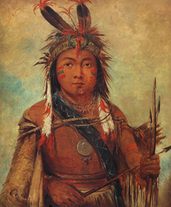
The history of Indians in Nebraska is both interesting and gruesome. Indians have some of the most culturally rich histories of any people groups out there. They lived off the land and had a strong sense of right and wrong. Their simplistic way of life may seem naive by todays standards but made them strong, hearty, spiritual, and independent.
Paleo-Indian Era
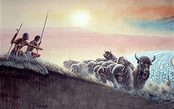
The first peoples that lived in Nebraska arrived around 10,000-12,000 years ago. It is widely believed they came over a land bridge from asia to North America following mammoths. They were mainly hunters and probably foraged some as well. Not much is known about them except that they followed their food and hunted with spears. All relics of their religious beliefs and ways of life have withered away with time.
Archaic Indian Era
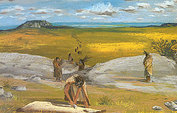
Around 9,000 years ago the weather in Nebraska stabilized and Indians set regular patterns in their movements throughout the U.S. The invention of the Atlatl made spear throwing more accurate, increased throwing distance, and increased throwing speed. Evidence also suggests Indians returned to sites over the years and increased their use of wild plants for both food and medicine.
Plains Woodland Indian Era

Somewhere between 1,000-2,000 years ago the Native American population had a boom and Indians began to discover farming. As more people were needed for the farming process and farming provided enough food for many new people, thus the two things are closely intertwined. The Indians also started hunting smaller game such as bison, deer, and antelope. Near the end of this period indians started to grow plants such as beans, squash, gourds, berries, and corn near somewhat permanent villages.
Central Plains Indian Era
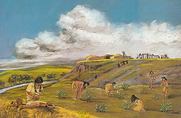
Between 650-1200 years ago was the Central Plain Indian era. Indians had another population boom. During this time the art of hunting with a bow and arrow was perfected making game easier to kill. Also farming methods had been honed and techniques for storing food had been developed making the perfect culmination of circumstances for the Indians.
Protohistoric Indian Era

Around 400 years ago Indians moved back to Nebraska after what appeared to be a drought cycle. This was also the beginning of written Indian history. This era is still considered to be going today. In this period Indians made contact with the first white settlers, which would eventually prove to be the downfall of many of their societies. Indian feuds were heated up when Europeans introduced guns and other desirable goods in which the Indians used to fight, and fought over.
A Terrible Legacy
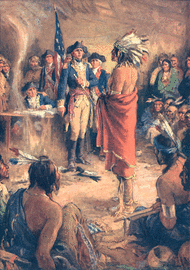
By the 1750's Great Britain had also staked its claim in the New World and told the colonists they could have any of the land from sea to sea despite the fact most of that land was owned by the French and the Spanish. By 1754 the colonists advancement west had enraged the French and Indians so much war had begun. The French and Indian war lasted from 1754 to 1763 where eventually the French lost support from the Indians and backed down. One of the major results of this war was the attitude of colonists towards Indians. Gone was what little sympathy and respect they had for the Native Americans. Despite the fact Indians were justified in their anger towards colonists they were now hated by the British settlers. The first of the many pushes towards the Indians to move west had begun.
For hundreds of years Indians had roamed the central United States. In that sense, they owned it. But in 1802 the U.S. purchase 828,000 square miles of land from France that nearly doubled the size of the United States. This deal caused settlers to start entering the area at a fast rate, pushing Indians farther and farther back. Although nobody would settle in Nebraska in the next few decades to come because of people claiming it to be a "desert" the Native Americans greatly suffered from this transaction.
Shortly after the Louisiana purchase an expedition called the Corps of Discovery explored this newfound land. Read more about this expedition here.
Eventually people would start following Lewis and Clark and began moving west. They started heading to Oregon and California and when the 1849 gold-rush kicked in Indians were pushed further aside in futile attempts at wealth.
By about the Civil war the government had realized their mistake in calling Nebraska a desert. They saw the land for what it was and wanted it both for farming and to build the Transcontinental Railroad. There was only one problem, they had promised the land to the Native Americans. It was then that the government began its brutal three step plan towards the Indians.
1. They would move the Indians to Oklahoma, which was actually useless to the U.S. at the time. Several Indians would die here as a result of little game and different farming conditions.
2. They would change the Indians. They had control over the Indians food source and used it as leverage to get Indians to learn the ways of Americans by way of schools and churches.
3. They would kill any Indians that were not on reservations. Women, children, babies, it didn't matter. The army brutally killed hundreds of Indians simply for being on land that had previously been promised to them.
Eventually people would hear the pleas of the Indians and help them get out of the governments iron grip on them.
For hundreds of years Indians had roamed the central United States. In that sense, they owned it. But in 1802 the U.S. purchase 828,000 square miles of land from France that nearly doubled the size of the United States. This deal caused settlers to start entering the area at a fast rate, pushing Indians farther and farther back. Although nobody would settle in Nebraska in the next few decades to come because of people claiming it to be a "desert" the Native Americans greatly suffered from this transaction.
Shortly after the Louisiana purchase an expedition called the Corps of Discovery explored this newfound land. Read more about this expedition here.
Eventually people would start following Lewis and Clark and began moving west. They started heading to Oregon and California and when the 1849 gold-rush kicked in Indians were pushed further aside in futile attempts at wealth.
By about the Civil war the government had realized their mistake in calling Nebraska a desert. They saw the land for what it was and wanted it both for farming and to build the Transcontinental Railroad. There was only one problem, they had promised the land to the Native Americans. It was then that the government began its brutal three step plan towards the Indians.
1. They would move the Indians to Oklahoma, which was actually useless to the U.S. at the time. Several Indians would die here as a result of little game and different farming conditions.
2. They would change the Indians. They had control over the Indians food source and used it as leverage to get Indians to learn the ways of Americans by way of schools and churches.
3. They would kill any Indians that were not on reservations. Women, children, babies, it didn't matter. The army brutally killed hundreds of Indians simply for being on land that had previously been promised to them.
Eventually people would hear the pleas of the Indians and help them get out of the governments iron grip on them.
Road to Redemption
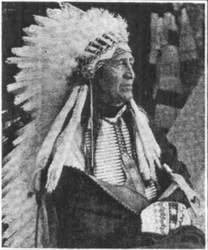
In the 1870's the Ponca tribe had been pushed of their reservation in Nebraska so that it could be given to the Sioux. They were then forced to move to Oklahoma where nearly one-third of their 500 members died from sickness or malnutrition. Among the sick was the Chief's son Bear Shield. His last dying wish was to be buried in his ancestral land along the Niobrara River. Chief Standing Bear and a group of about 60 other Ponca headed towards Nebraska. The journey took several weeks but when they finally reached an Omaha Reservation they were welcomed as family. Word of their presence soon reached the government who sent General George Crook to apprehend them. Crook told the story to Thomas Hibbles of the Omaha Daily Herald who publicized it widely. Attorney John L. Webster offered his services free of charge to make a case against Standing Bear being apprehended. The Federal Judge Dundy eventually declared that an "Indian is a person" and that the federal government could not legally confine them to reservations. Thus freeing the Indians from Oklahoma.
Although this case did wonders for the human rights of Indians it still wasn't until 1924 that Indians were granted citizenship under the law.
Although this case did wonders for the human rights of Indians it still wasn't until 1924 that Indians were granted citizenship under the law.
